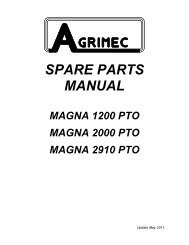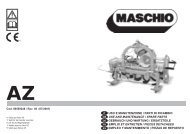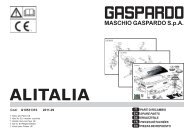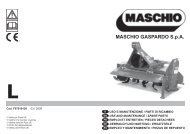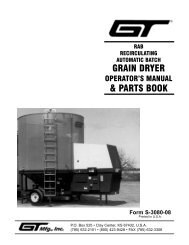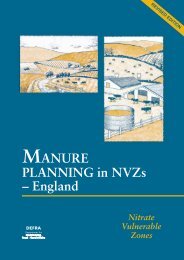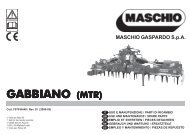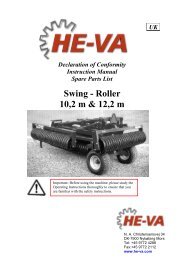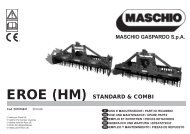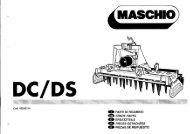DM_RAP_COMBI_rev03 IN LAVORO.pmd - Opico
DM_RAP_COMBI_rev03 IN LAVORO.pmd - Opico
DM_RAP_COMBI_rev03 IN LAVORO.pmd - Opico
Create successful ePaper yourself
Turn your PDF publications into a flip-book with our unique Google optimized e-Paper software.
ITALIANO<br />
ENGLISH FRANÇAIS DEUTSCH<br />
ESPAÑOL<br />
Istruzioni per l’abbassamento<br />
della protezione laterale ribaltabile:<br />
1) Inserire un utensile nel perno di bloccaggio<br />
della protezione.<br />
2) Spingere il perno lungo il suo asse, fino a<br />
sbloccare la rotazione della protezione.<br />
3) Abbassare la protezione in posizione di<br />
lavoro fi no a quando il perno di bloccaggio,<br />
inserendosi automaticamente nel foro<br />
“X” (vedi Fig.B), blocca la protezione in<br />
posizione abbassata di lavoro.(Fig.A).<br />
3.17 <strong>IN</strong> <strong>LAVORO</strong><br />
Iniziare il lavoro con la presa di forza<br />
a regime, affondando gradualmente la<br />
macchina nel terreno.<br />
Evitare di premere sconsideratamente il<br />
pedale dell’acceleratore con la presa di<br />
forza inserita.<br />
Questo può essere molto dannoso per la<br />
macchina oltreché per il trattore stesso.<br />
Per scegliere lo sminuzzamento più<br />
idoneo del terreno, è necessario tenere<br />
in considerazione alcuni fattori e precisamente:<br />
- natura del suolo (medio impasto - sabbioso<br />
- argilloso - ecc.).<br />
- profondità di lavoro.<br />
- velocità di avanzamento del trattore.<br />
- regolazione ottimale della macchina<br />
Un’elevato sminuzzamento del terreno<br />
si ottiene con una velocità bassa di<br />
avanzamento del trattore; un minor<br />
sminuzzamento si otterrà aumentando<br />
la velocità del trattore.<br />
How to lower the folding side<br />
protection:<br />
1) Insert a tool into the pin that locks the<br />
protection.<br />
2) Push the pin along its axis until the<br />
rotational movement of the protection has<br />
been released.<br />
3) Lower the protection to the work position<br />
until the locking pin automatically fi ts into<br />
hole “X” (see Fig.B) and locks the protection<br />
in the lowered work position (Fig.A).<br />
3.17 <strong>IN</strong> WORK<br />
Begin work with the pto at running rate,<br />
gradually digging the machine into the<br />
soil.<br />
Avoid depressing the accelerator pedal<br />
to an excessive extent when the pto is<br />
engaged.<br />
This could cause serious damage to both<br />
the machine and the tractor.<br />
To choose the best soil working degree,<br />
it will be necessary to consider certain<br />
factors, i.e.:<br />
- the nature of the soil (medium texture<br />
- sandy - clayey, etc.).<br />
- the work depth.<br />
- the advancement speed of the tractor.<br />
- optimum machine adjustment.<br />
A through crumbling of the soil is obtained<br />
with a low forward speed of the<br />
tractor; the crumbling effect is reduced<br />
by increasing the speed.<br />
Instructions pour abaisser la protection<br />
latérale basculante : -<br />
1) Introduire un outil dans l’axe de blocage<br />
de la protection.<br />
2) Pousser la broche le long de son axe, jusqu’à<br />
débloquer la rotation de la protection.<br />
3) Abaisser la protection en position de travail<br />
jusqu’à ce que la broche de verrouillage<br />
pénètre automatiquement dans l’orifice “X”<br />
(voir Fig.B) et bloque la protection en position<br />
abaissée de travail. (Fig. A).<br />
3.17 EXECUTION DU<br />
TRAVAIL<br />
Commencez le travail avec la prise de<br />
force au régime et enfouissez graduellement<br />
la machine dans le sol.<br />
Evitez d’appuyer trop fort sur la pédale<br />
d’accélérateur quand la prise de force est<br />
embrayée. Ce qui serait très dangereux<br />
pour l’appareil et le tracteur.<br />
Pour choisir le hersage le plus approprié<br />
il faut prendre en compte quelques facteurs<br />
et plus précisément:<br />
- nature du sol.<br />
- profondeur de travail.<br />
- vitesse d’avancement du tracteur.<br />
- réglage optimal de la machine.<br />
On obtieent un émiettentement élevé du<br />
terrain avec une faible vitesse d’avancement<br />
du tracteur; et inversement en<br />
augmentant la vitesse du tracteur.<br />
Anleitungen zum Senken des klappbaren<br />
Seitenschutzblechs:<br />
1) Ein Werkzeug in den Sperrbolzen des<br />
Schutzblechs stecken.<br />
2) Den Bolzen längs seiner Achse schieben,<br />
bis das Schutzblech sich nicht mehr drehen<br />
kann.<br />
3) Das Schutzblech in die Arbeitsposition<br />
senken, bis der Sperrbolzen automatisch<br />
in das Loch “X” einrastet (Abb. B) und<br />
das Schutzblech dann in der gesenkten<br />
Arbeitsposition blockieren (Abb. A).<br />
3.17 BEI DER ARBEIT<br />
Die Arbeit beginnen, wenn die Zapfwelle<br />
ihre Drehzahl erreicht hat, und den<br />
Maschine dann allmählich in den Boden<br />
einsenken lassen.<br />
Vermeiden, zu stark Gas zu geben, wenn<br />
die Zapfwelle eingeschaltet ist. Das kann<br />
zu größeren Schäden am Maschine und<br />
auch am Schlepper führen.<br />
Um den idealen Zerkleinerungsgrad für<br />
den Boden zu finden, müssen einige Faktoren<br />
berücksichtigt werden, und zwar:<br />
- Beschaffenheit des Bodens (normal,<br />
sandig, lehmig etc.).<br />
- Arbeitstiefe.<br />
- Schlepperfahrgeschwindigkeit.<br />
- Optimale Krümlereinstellung.<br />
Bei niedriger Vorschubgeschwindigkeit<br />
des Schleppers wird das Erdreich stark<br />
zerbröckelt, durch die Geschwindigkeitssteigerung<br />
des Schleppers wird eine<br />
weniger starke Zerbröckelung erzielt.<br />
Instrucciones para el descenso de la<br />
protección lateral volcable:<br />
1) Introducir una herramienta en el perno de<br />
bloqueo de la protección.<br />
2) Empujar el perno a lo largo de su eje, hasta<br />
desbloquear la rotación de la protección.<br />
3) Hacer descender la protección en<br />
posición de trabajo hasta que el perno de<br />
bloqueo, introduciéndose automáticamente<br />
en el agujero “X” (véase Fig.B), bloquee la<br />
protección en posición baja (de trabajo)<br />
(Fig.A).<br />
3.17 EN FUNCIONAMIENTO<br />
Iniciar el trabajo con la toma de fuerza<br />
en régimen, hundiendo gradualmente la<br />
máquina en el terreno.<br />
Evitar de apretar excesivamente el pedal<br />
del acelerador con la toma de fuerza acoplada.<br />
Esto puede resultar muy dañoso<br />
para la máquina y para el tractor mismo.<br />
Para elegir el desmenuzamiento más<br />
idóneo al terreno, es necesario considerar<br />
algunos factores, y en especial:<br />
- tipo de suelo (mezcla media - arenoso<br />
- arcilloso - etc).<br />
- profundidad de trabajo.<br />
- velocidad de avance del tractor.<br />
- regulación optimal de la máquina.<br />
Se obtiene un desmenuzamiento elevado<br />
del terreno con una velocidad de avance<br />
del tractor baja; por el contrario, aumentando<br />
la velocidad del tractor, se obtiene,<br />
un desmenuzamiento menor.<br />
MAX km 8/h<br />
62<br />
Fig. 82a<br />
Fig. 82b<br />
Fig. 83



